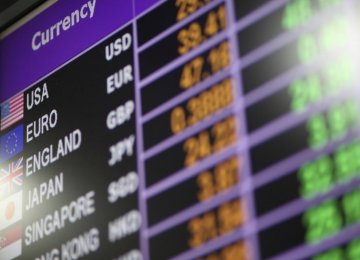After a four week rout, the rial is on the rebound as the weakened currency spurred some buying.
The dollar fell against the rial on Saturday heading for the first full week of losses in months.
The rial rose against all major currencies including the euro and sterling, which were among the hardest hit, as the equity market plummeted to a 15-month low in Tehran.
December was the worst month in 2014 when the rial fell over seven percent against a basket of currencies, the currency is in for a correction as traders sell their currencies to lock in profits.
On Dec. 29, when questioned on the recent depreciation of the rial the governor of the Central Bank of Iran said the recent “volatility” in the market was due to seasonal reasons [approaching the end of the Gregorian year] and that pressure on the rial was likely to subside throughout January.
The Japanese yen dropped the most against the rial, among major currencies. The yen plunged 3.45 percent to 290 rials after the currency closed lower versus the dollar on Friday’s close.
Sterling slid 1.87 percent to 53,500 rials by 12:24 GMT on Saturday, to a three week low.
The euro fell over 1.07 percent and was exchanged at 42,100 rials, in Ferdowsi Street – center of currency trade in Tehran.
The greenback proved the most resilient of the lot. The US currency clung on to its gains, slipping 0.2 percent to 34,890 rials. The dollar is retreating from an 18-month high versus the rial.
Other currencies fell as well. The Canadian dollar fell 1.41 percent to 30,500 rials while the Aussie dollar dropped just shy of a percentage point to 28,380.
Money seems to be flowing into bank accounts as the Tehran Stock Exchange’s main index slipped further below the 68,000 mark, edging down 0.21 percent to a record low of 68,829.00, based on TSE data.
The Tehran Stock Exchange’s index has lost 20.8 percent in 2014, set for the first yearly decline since 2008, as petrochemical companies and lenders plunged.
Analysts cite the ongoing uncertainty over the fate of Iran’s sanctions, the widening budget deficit which fuels speculation that the government will have to monetize the deficit and the plunge in crude oil prices as the main reasons for the downtrend that is currently holding down equities.
Oil prices are at a 5-1/2 year low on pressured by weakening demand and a supply glut prompted by the US shale boom and OPEC’s refusal to cut output. Crude oil is heading for its worst year since 2008.
The Brent oil benchmark closed 91 cents or 1.59 percent lower at $56.42 per barrel on Friday. The West Texas Intermediate fell 1.09 percent to $52.69 per barrel, according to Bloomberg generic pricing.
Global benchmark Brent crude has fallen 49.5 percent in 2014 as demand growth slowed, the United States expanded output and OPEC, dropping its strategy of trimming supply to keep oil around $100 a barrel, chose instead to defend market share.





